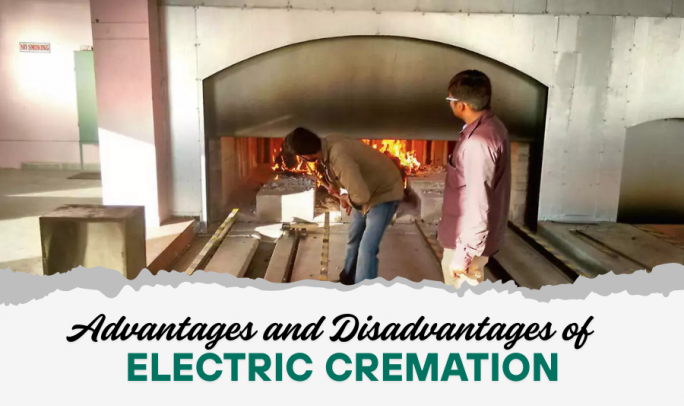Lastjourney Blog
Advantages and Disadvantages of Electric cremation

 Table of Contents
Table of Contents- What are the key advantages of Electric Cremation?
- What are the key Disadvantages of Electric Cremation that one can not ignore?
- Why Choose Electric Cremation?
- Conclusion
The concern regarding the environmental conditions grow, people are continuously looking for reliable and sustainable options in each aspect of life—including death related rituals.
Ancient/traditional cremation ways, such as wooden, cow dung or gas-based cremation, causes severe damage to the environment such as deforestation, air pollution, and greenhouse gas emissions etc. While on the other hand, electric cremation is evolving as an eco-friendly alternative that minimizes overall impact on environment.
Similar to any technological advancement, it has its own set of advantages and disadvantages. Here, in this article, we will learn about the benefits and limitations of electric cremation. It will help individuals and families make right decisions.
What are the key advantages of Electric Cremation?
1. Environmentally Friendly
One of the primary advantages of electric cremation is its positive impact on the surroundings. Not like the, traditional cremation methods that depends on combustioning wooden logs or gas, electric cremations does not require firewood. It reduces deforestation on a large scale and keep the natural resources protected.
Apart from it, electric cremation does not produce any harmful emissions such as carbon monoxide, sulfur dioxide, or mercury etc.
It lowers down the level of air pollution. Hence it has become a safer and cleaner alternative. Electric cremation also supports sustainable funeral practices by reducing the carbon footprint during cremation.
2. Lowering the Carbon Footprint during cremation
During the Electric cremation, the amount of carbon dioxide emits in a very low quantity. Hence the significant reduction of carbon dioxide (CO₂) compared to firewood or gas-based cremation is the another advantage of choosing Electric Cremation over the traditional wooden one.
In the direct combustion a fewer greenhouse gases are emitted. But when the renewable energy sources like solar or wind are used in the cremation, their negative impact on the environment gets heavily minimized. It helps cities and regions meet climate change goals determined by the government authorities by providing a cleaner alternative to the people of that particular area.
3. It's Cost-Effectiveness in the Long Run
There is no doubt in accepting that the initial setup of Electric Cremation costs falls on the higher side but its long-term benefits make it a cost-effective solution comparatively.
It does not require any expenses for firewood or gas procurement. It lowers the operational costs due to automatic functioning of tools/equipments and their better efficiency. Some governments offer financial incentives for adopting environmentally friendly cremation methods as well.
4. Less time-consuming and More Efficient Procedure for cremation
Electric cremation takes much less time than traditional wooden cremation methods. And the reason behind it is its fully controlled and identical heat distribution.
While in the other hand, the traditional wooden cremation based on firewoods, coelw dung cakes take hours in completely cremating the dead body. It requires very less manual labour which makes it seamless and efficient alternative. The crematorium staff members can process more cremations in a day, reducing wait times for grieving families.
5. Cleaner and Hygienic
Not like the open-fire cremation, electric cremation happens in a controlled environment that ensures there is no harm in scattering of ashes or residual pollutants in the water body or a ground. It minimises the risk of contamination from burning fuels. The smoke-free and cleaner atmosphere in crematoriums makes it a more dignified experience for the mourning ol families of the departed ones.
Also Read, Cost of Electric Cremation vs. Traditional Cremation: Is It Worth It?
What are the key Disadvantages of Electric Cremation that one can not ignore?
1. High Initial Electric Cremation Setup Cost
It is one of the biggest drawbacks of electric cremation is its initial infrastructure cost.
Crematoriums must invest in electric furnaces, which are expensive. Installation and maintenance costs are higher compared to traditional cremation. Facilities may need backup power solutions to prevent service disruptions.
2. Dependence on Electricity
Electric cremation relies entirely on electricity, which presents certain challenges:
Power cuts or fluctuations can disrupt the process. High electricity consumption, particularly if renewable energy sources are not used. If powered by coal-based electricity, it may still contribute to carbon emissions.
3. Limited Availability
Not all crematoriums offer electric cremation due to infrastructure constraints.
Many regions, especially rural areas, lack the necessary setup. Widespread adoption requires significant investment and policy changes. Families may have to travel to access electric cremation facilities.
4. Cultural and Religious Acceptance
For many cultures, traditional cremation methods hold deep religious and spiritual significance.
Some communities prefer open flames as part of their funeral rites. The lack of a visible fire may feel less symbolic to certain religious traditions. It may take time for wider acceptance of electric cremation in deeply traditional societies.
5. Not Completely Carbon-Free
Although electric cremation is more environmentally friendly, it is not entirely carbon-neutral.
If the electricity used is sourced from non-renewable energy, it can still contribute to carbon emissions. To maximize sustainability, crematoriums should integrate solar, wind, or hydroelectric power sources.
Why Choose Electric Cremation?
Electric cremation is gaining popularity for its eco-friendly benefits, cost-effectiveness, and efficiency. Despite certain challenges such as infrastructure costs and cultural adaptation, it presents a compelling alternative to traditional cremation.
Key Takeaways:
- Eco-friendly: Reduces pollution and prevents deforestation.
- Lower carbon footprint: Produces fewer greenhouse gases.
- Cost-effective in the long run: No need for firewood or gas procurement.
- Hygienic and safe: Smoke-free, cleaner, and more dignified process.
- Urban-friendly: Ideal for densely populated areas with limited space.
- High initial costs: Expensive infrastructure setup.
- Electricity dependency: Requires a stable power supply.
- Limited availability: Not accessible in all locations.
- Cultural adaptation: Some traditions prefer open-flame cremation.
- Not entirely carbon-free: Depends on electricity sources.
Also Read, 5 Myths and Facts About Electric Cremation
Conclusion
Electric cremation is a modern, environmentally responsible alternative that aligns with the growing need for sustainable funeral practices. While it has certain drawbacks, such as infrastructure costs and energy dependency, its long-term benefits make it a preferred choice for many families. As awareness increases and technology advances, electric cremation is likely to become more widely available, making it an integral part of eco-friendly end-of-life solutions.
For those looking for a dignified, clean, and future-forward cremation method, electric cremation is a step toward sustainability and a greener planet.
Your email address will not be published. Required fields are marked *












